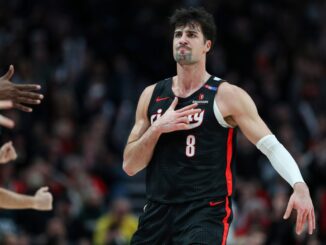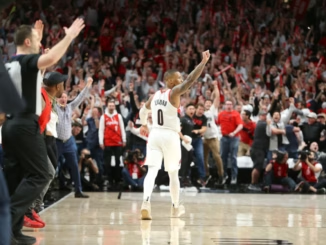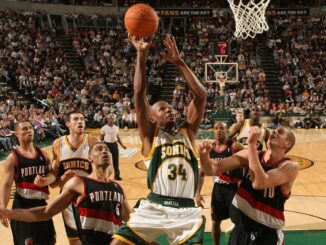
On occasion, Oregon Sports News will highlight a significant figure in Portland Trail Blazers history. After 50 years, plenty of triumphs, and many tragic blunders, the Blazers’ past is a rich gold mine that isn’t tapped into nearly enough. We’re going to change that. Welcome to the Trail Blazer History Highlight.
Today’s subject is the OG Blazer, Geoff Petrie.
How He Got Here
The year is 1970. The NBA is going through a period of tentative growth and sudden transition; Bill Russell had retired a year earlier, Wilt Chamberlain, Jerry West and Elgin Baylor were aging, the young man who would eventually be known as Kareem Abdul-Jabbar was a rookie sensation playing in the nether reaches of Milwaukee, and the New York Knicks…were actually really good for a few years.
The ABA had also come into being on the East Coast, eventually spreading to Indiana and Denver, among other places. The ABA was diluting the player pool, taking much of the exciting young talent and shoving them into obscurity, including Julius Erving—a significant part of not only pro basketball history, but Trail Blazer history.
Commissioner Walter Kennedy had awarded three cities NBA franchises: Cleveland, Buffalo and Portland. Oddly enough, the city of Portland had built the Memorial Coliseum a decade earlier, but then-commish Maurice Podoloff had refused to grant the Rose City a franchise, saying it was too far West and too small.
Kennedy, facing pressure from the ABA’s expansion and desiring another Western franchise to compete with Seattle, Phoenix and the California franchises, granted Harry Glickman a franchise and the 8th overall pick. Sweet.
Now, what to do with that pick? Glickman could fill out the roster with veterans (and the Expansion Draft helped him do just that), but the first pick in the actual NBA Draft would set the tone for the whole organization. That player would be the face of the franchise and a big part of its future. Glickman ended up selecting a six-foot-four, 190-pound guard/forward out of Princeton named Geoff Petrie.
Looking back at the 1970 Draft, you could make the case that if current NBA Draft rules applied back then for expansion franchises, Portland would have been MUCH better off. If they picked 1st overall, they could have had their choice between center Bob Lanier (a Hall of Famer, first overall pick of this draft, and eight-time All-Star), forward-center Dave Cowens (a Hall of Famer, two-time NBA Champion, MVP, and eight-time All-Star), or Pistol Pete Maravich (a Hall of Famer, one of the most iconic players of all time). Hell, even the third pick would have given them the third choice out of that group—which would still have been pretty damn good!
Instead, Detroit got Lanier, Boston got their heir to Russell in Cowens, and New Orleans picked up the LSU legend in Pistol Pete. And we got stuck with the skinny Princeton snob. Great.
Another player who was available was Nate “Tiny” Archibald, but he went in the second round. Glickman likely never considered him, which is another shame—Tiny would go on to lead the league in both points and assists and reinvent himself as a key bench player for the 1981 NBA Champion Boston Celtics.
In retrospect, however, Petrie was likely the safest choice for the fledgling Trail Blazers. First off, he was white, and to be totally and brutally honest, Portland wasn’t ready to have a black man be the face of its premier sports team in 1970—the city had been desegregated only a few years earlier and tensions were still simmering. I’m not sure Cowens or Maravich would have been suitable either, since both had reputations of unreliability and instability, while Petrie was as steady and reliable as they came.
Secondly, he was well-educated and well-mannered; Ivy League guys tend to be those things when their parents don’t enable them to be spoiled bullies who dump on everyone beneath them. Petrie was a Southeastern Pennsylvania boy born in a Quaker town. He had the kind of upbringing that would appeal to Portlanders back then.
Most important, in basketball terms, was the fact that Petrie was pretty damn good. At Princeton, he won two Ivy League titles, made the NCAA Tournament in 1969, led the conference in scoring his junior year, and helped Princeton climb as high as eighth in the AP Poll during his time there. Petrie is still in the top five or 10 in virtually every career offensive statistic he qualifies for at Princeton, and given the history of that school’s basketball program, that’s nothing to sneeze at.
His Time in Portland
Petrie’s time donning those sweet old-school jerseys (with the not-so-sweet short shorts, though I guess that part of the uniform’s appeal is up to individual taste) wasn’t productive in terms of on-court results. As an expansion franchise, the Trail Blazers predictably struggled, failing to record a winning season during Petrie’s tenure.
Those struggles weren’t the OG’s fault, though. His stats were quite impressive for a Jerry West wannabe, including setting franchise records that would stand for decades. To this day, Petrie is in the top 10 in points, field goals, assists, points per game, and minutes per game for the Blazers, and along with running buddy/moral antithesis Sidney Wicks, made some waves in the backcourt as Glickman and Stu Inman made a bevy of errors in the frontcourt (LaRue Martin, anyone?) until Bill Walton fell from the heavens.
The proto-Blazers may have sucked, but that didn’t stop Petrie from making two All-Star teams (including in his rookie season), winning co-Rookie of the Year with Cowens (an achievement Wicks would earn the following year—I believe that’s the last time a team has fielded consecutive ROYs), averaging 24 PPG three times in six years (and averaging around 18 PPG the other three years), or rocking the most awkward pudding bowl-sideburns combo this side of a ‘70s porno. He wasn’t all that flashy, but he was effective, especially as a jump shooter—West is probably the player most hurt by the lack of a three-point line in NBA history, but Petrie should be in the top 10 of that category too.
The OG had many firsts for the Blazers, including the first 50-point game in franchise history (it would be 40 years until Damon Stoudamire broke Petrie’s record with 54. Then some dude named Damian Lillard came along and started using the Trail Blazers record book as kindling for the fire he’s been bathing NBA defenses in), but his historical peak as a player came when he was traded during the summer of 1976 to Atlanta for the second pick in the ABA Dispersal Draft. Petrie went to Atlanta, but unfortunately, he tore up his knee before playing a game for the Hawks. He was done after just six seasons, as this was before knee tendon repair was fully mastered by surgeons.
As for the pick Petrie was dealt for…Portland used it on Maurice Lucas.
It’s rare that one franchise icon gets exchanged for another in trades, but Stu Inman has many moments when he was running the Blazers—great and terrible.
Petrie’s involvement with the Blazers wasn’t finished there, however. After spending some time in the private sector, he decided to get back into basketball, working as a broadcaster for the Blazers starting in 1985. He bounced around the booth and front office before becoming Portland’s head honcho after Bucky Buckwalter’s retirement shortly after the 1992 NBA Finals. He didn’t stay there long, though, as the Sacramento Kings hired him as their President of Basketball Operations in 1994.
I wonder whether the troubles that started to plague the Blazers—Clyde Drexler’s departure, the middling performances, then the collapses in 1999 and 2000 followed by the Jail Blazers—began when Petrie departed Rip City. It’s a theory that gets some legs when you consider what Petrie did in Sacramento.
Post-Blazers
While baby boomers may know Petrie best as an All-Star-level player struck down too soon by crappy shoes and bum knees, my generation probably knows him best as the architect behind the Kings’ best teams since Oscar Robertson was sneering and grumbling in Cincinnati. Those turn-of-the-millennium Kings were extremely good, probably the best team never to make the NBA Finals (Steve Nash’s Phoenix Suns are also a contender here), and Petrie’s stewardship steadied a franchise that had been adrift—figuratively and literally—since Robertson’s day.
While the Kings never returned to those heights, the Maloof brothers were either too lazy to fire him, or too afraid to further alienate the Sacto fan base, so he stayed until 2013. While it’s true that the Kings had been a rotting husk of their former glory by the time Petrie was canned, he was far from their only problem. I mean, look at them today; they would be the most disorganized heap of a franchise if the Knicks didn’t exist.
Petrie may be turning 72 in a couple months, but I’d bet he’s still a better executive than Vlade Divac.
Random Nugget ‘O the Day
According to Wikipedia, Petrie was the first player to switch from Converse sneakers to Nikes. While it would make obvious sense that Portland’s franchise player would make that switch, how much can you really trust Wiki? Still, the image of Phil Knight hawking sneakers out of the back of his car to Geoff Petrie makes me snicker.
Bonus nugget: Petrie won Executive of the Year twice for the Kings, in 1999 and 2001. To my knowledge, only two men won that award while also having been Rookie of the Year and an All-Star as NBA players. Petrie is one. The other is Larry Bird.
And that was your Blazer Homer Cherry-Picked Stat for the week. Enjoy.




